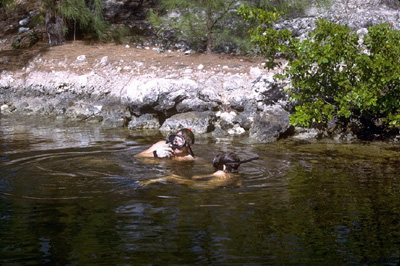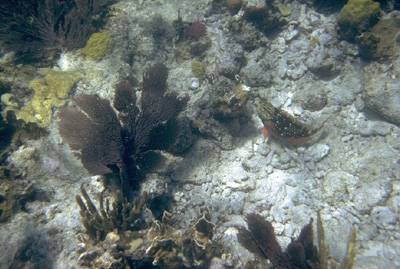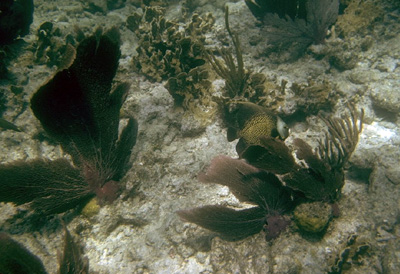
Snorkeling gives unique views of coral reef
HOMESTEAD, Fla. — When people think of a national park, they envision large stretches of wild and untouched land, packed with native plants and animals.
At Biscayne National Park here, the story is different. Located in South Florida, about a half hour south of Miami, this park has little land at all, where 95 percent of its territory is water.
Known for its glass-bottom boat tours, snorkeling and scuba diving, this park is a coral reef-lover’s paradise. In fact, Biscayne Bay is one of the leading scuba dive locations in the United States.
 |
Two snorkelers explore the waters near the shoreline at Biscayne National Park (Photo courtesy of the National Park Service). |
Situated near metropolitan Miami, it is a wonder that this area of 207 square miles hosts more than 200 species of tropical fish and several types of coral.
Excited families, rounding up their young, put on life vests as they board the trusty medium-sized boat. When all are safely seated, we are told that the currents are especially strong, and to be particularly careful when swimming. A couple inexperienced swimmers leave the boat, while most of the passengers are excited to tough out the waters.
While driving over to the selected “best spot,” we are handed out our flippers, goggles and scuba gear.
Snorkeler Cory Wright explained why she makes the trip out to the national park.
“Snorkeling is unlike any other activity. It allows you to concentrate on steady breathing, while immersed in clear, beautiful oceans. For a few hours, I am able to clear my head and appreciate the simplicity of our natural earth,” Wright said.
The boat stops and it is time to jump out into a sea filled with mysterious sea creatures.
Sitting on the edge of the boat, I dip my flippers into the cool, sapphire water. I wonder what is underneath the mask of blue that conceals the secret world below.
A chilly fresh rush overcomes my body. I feel free.
| Coral in Biscayne Bay that is part of the coral reef system in Biscayne National Park (Photo courtesy of the National Park Service). |  |
The instructor tells us to face down and to use only our legs to maneuver. We use life vests that can be deflated in case we want to do something known as “free diving.”
After taking a deep breath, you can dive deeper, towards the particular object of interest.
I lie on top of the ocean and gaze down. Soft corals are shifting along with the lazy waters. Colorful fish are clustered around sea fans.
I notice that much of the coral looks as though it has been bleached. This might be due to a temperature increase. Coral is known to feed on colored algae.
However, when there is a rise in temperature, the algae releases and the coral is left a pasty-white and foodless being. Although this does not kill the coral in the short-term, if left without algae for a long period of time the coral has a serious risk of surviving.
Human activity also poses a severe threat to coral. Daniel Lenihan, director of the National Park Service’s Submerged Cultural Resource Unit, and John D. Brooks, an underwater photographer with the unit, wrote the book Underwater Wonders of the National Parks. In it they describe the etiquette of a responsible snorkeler.
A golden rule is to keep your hands to yourself. Many species are coated in a protective layer of mucous, and touching them can lead to their death.
Another suggestion is to be gentle while swimming. If coral is covered in sand moved by swimmers, sunlight will be blocked and the chance of survival will be narrowed.
While snorkeling, you should also be cautious of your body. Remember that while in water, the sun’s power is accelerated by the thin layer of water coating your body, so sun block should always be used. Keeping a lookout for jellyfish, sea urchins, barracudas, and sharks is also part of conscientious snorkeling.
Lenihan and Brooks also suggest swimming into the current so when the trip is over, the way back to the boat is not as tiresome.
After I have had my fill of sea life, I swim back to the boat and shed my diving gear. Laying on the bow of the boat I watch the breathing tubes of swimmers bobble up and down along with the movement of the water.
The sun beats down on my back as I rest my head in my hands and I feel as though all the stress has been sucked out of my body.
 |
Living coral in Biscayne Bay and Biscayne National Park (Photo courtesy of the National Park Service). |
The captain rings a bell and notifies the swimmers that it is time to go back to shore. As people return to the boat, they exchange words about the things they saw. One person claimed to see a three-foot lobster, while another described his fear for a giant fish that was going to eat him.
We cruised back to the green shore and were awaited by happy families having cookouts on the grills provided by the park. Biscayne National Park proved itself to live up to their claims of a unique atmosphere.
As I drove back to my residence in South Beach, I was excited that I had found an activity that could be done with such ease and surprisingly so little planning.
Snorkeling confirmed itself to be a relaxing, stimulating, and beautiful work out.
Living in South Florida, I will attempt to make snorkeling my new obsession.
If You Go
Hours/Fees: Certified scuba divers -Saturdays and Sundays from 8:30 a.m. to 1 p.m. for $54.
Snorkeling trips are available every day from 1:30 p.m. to 4:30 p.m. for $35.
Reservations: Made by phone / in person. Information: 305-230-1100.
Facilities: Convoy Point –parks headquarters is open daily from 7 a.m. to 5:30 p.m.
Dante Fascell Visitor Center– open daily from 9 a.m. to 5 p.m.
Directions:
- From the North: Convoy Point can be reached from either the Florida Turnpike or from U.S. 1. From the Florida Turnpike: Take the Florida Turnpike south, to Exit 6 (Speedway Blvd.). Turn left from exit ramp and continue south to SW 328th Street (North Canal Drive). Turn left and continue to the end of the road. It is approximately five miles, and the entrance is on the left.
- From U.S. 1: Drive south to Homestead. Turn left on SW 328th Street (North Canal Drive), and continue to the end of the road. It is approximately nine miles, and the entrance is on the left.
- From the South: Traveling on U.S. 1 (Overseas Highway), drive north to Homestead. Turn right on SW 328th Street (North Canal Drive — first light after Florida Turnpike entrance), and continue to the end of the road. The entrance is approximately nine miles on the left.

Comments are Closed